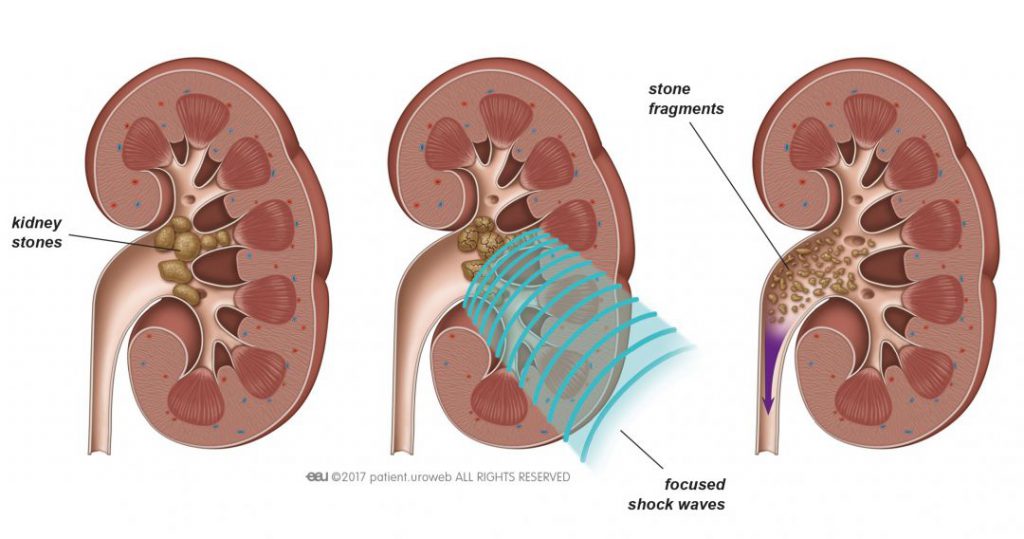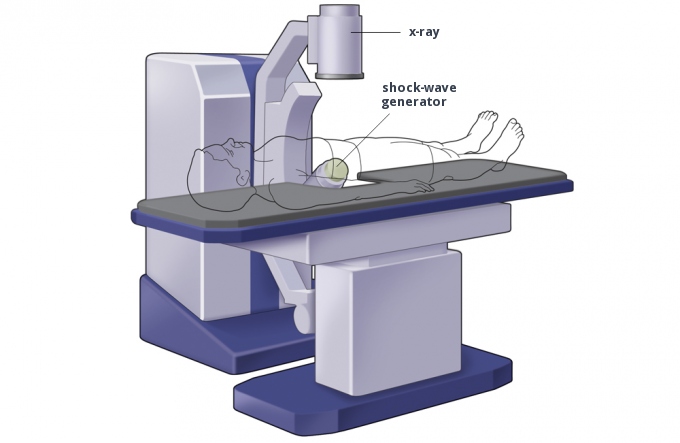Table of Contents
This information on shock-wave lithotripsy (SWL) explains the procedure and includes an animation of what happens during the procedure.
Shock-wave lithotripsy (SWL) is done with a machine that can break kidney stones from outside the body. To break the stone, focused shock waves (short pulses of high energy sound waves) are transmitted to the stone through the skin. The stone absorbs the energy of the shock waves and breaks into smaller pieces. The stone fragments then pass with urine.
The procedure
- There is usually no need for general anaesthesia, but pain medication is administered for comfort during the procedure.
- During this procedure, you are placed on an operating table with your side and lower back positioned towards the shock-wave generator.
- Focused shock waves are transmitted to the stone through the skin. The stone absorbs the energy of the shock waves and breaks into pieces as small as grains of sand.
- Because of their small size, these pieces can pass easily from the body along with the urine when you go to the toilet after the procedure.
- The procedure lasts about 45 minutes. If you have a large stone, you may need several sessions to completely break it.
When is SWL not recommended?
SWL is not recommended if:
- You are pregnant
- You have a high risk of severe bleeding
- You have any uncontrolled infections
- You have uncontrolled high blood pressure
- Your physique makes it difficult to reach the stone
- You have an aneurysm
- You have an anatomical obstruction in the urinary tract, below the stone or in the bladder
- Your stone is very hard (for instance cystine stones)
Preparation for the procedure
Always ask your doctor about the treatment steps and any special instructions. These can differ by hospital and country.
Instructions may include:
- When to stop certain medications, such as blood thinners or any other drugs that make it harder for your blood to clot
- When to stop drinking or eating before the treatment
- When to arrange pain medication after the procedure (if necessary)—discuss this early with your nurse and/or doctor
- Arranging a ride home after your hospital discharge
Medical Team
It is important that your care team is informed about your treatment. This means that besides the doctor and nurses in the hospital, who are responsible for your treatment, your general practitioner and other caregivers should be informed too, including family and friends.
Support and questions
It can help and make you feel more comfortable if your partner, relatives, or friends have read the information regarding the procedure. Write down all of your questions to remind you of any important points you need to discuss with your doctor or nurse.
Let someone accompany you to an appointment to help you remember any questions you may need to ask.
The operation
This animation shows what happens when you undergo shock-wave lithotripsy.
You are placed on an operating table with your side and lower back positioned towards the shock-wave generator. The exact location of your stone is determined by ultrasound or x-ray. During the procedure, you will be able to hear the shock waves being made; this sounds like little bangs. Your doctor will start at low intensity and slowly increase the strength of the waves. If you have a moderately large stone, it is quite common to need multiple sessions.
What to expect after the procedure
Usually, you can go home after the procedure is done. You do not have to spend a night in the hospital.
If you have received medication for pain, do not drive a car or operate any other motorized vehicle within the first 24 hours after the procedure. Make sure to arrange a ride home after your hospital discharge.
Will I be stone free directly after the treatment?
No. SWL breaks your stone into small pieces. These fragments will pass with urine in the days or weeks after SWL. You can get MET to help pass the stone fragments.
For more information about MET click here.
What to expect back home
SWL breaks your stone into small pieces. These fragments will pass with urine in the days or weeks after the procedure. You may have blood in your urine, but this should not last more than 2 days.
Your doctor may prescribe drugs to help you pass the fragments faster and to limit the pain that may occur as the fragments pass through your urinary system.
If you have received medication against the pain or to calm you down, do not drive a car or operate any other motorised vehicle within the first 24 hours after SWL.
How long will it take before I can get back to my normal daily activities?
In general, you can go back to your regular daily activities right after the treatment. However, make sure to get some rest on the day after the procedure.
After SWL:
- It is important that you drink more than usual to flush out stone fragments
- If you have renal colic, ask your doctor how much you should drink
- You may need to filter your urine to catch stone fragments for analysis
- Do not drink any alcohol in the first 24 hours after the procedure
You need to go back to the hospital right away if you:
- Develop a fever
- Feel pain in your kidney or side
- Still have blood in your urine more than 2 days after the procedure
Follow-up
Your doctor will schedule visits for regular control in the first few weeks after the procedure.
This is also necessary when you:
- Receive Medical Expulsive Therapy (MET) to help you pass stone fragments faster and to limit the pain that may occur as the fragments pass through your urinary system.
High risk of forming new stones
Some patients who have had kidney or ureteral stones may form more stones in the future. After your stone passes or is removed, your doctor will determine if you are at high risk of recurrence. To do so, he or she will need to analyse the stone. In addition, the doctor will consult the results of your blood and urine tests which were done before treatment.
For more information about metabolic evaluation click here.



